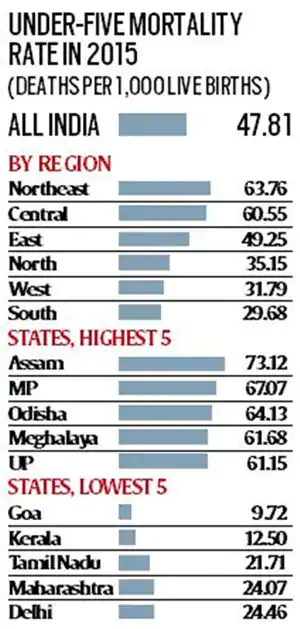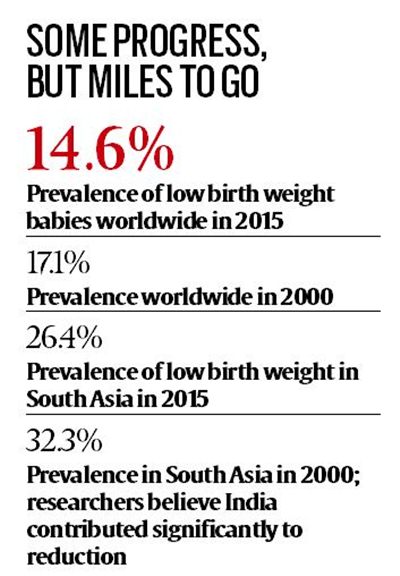Why in news?
The Lancet Global Health journal recently published the results of studies on under-five mortality and low birth weight.
How is under-five mortality rate?
- The deaths among children under five years in India was higher than in any other country in 2015.
- India has reduced annual mortality among children under five.
- It is down from 2.5 million in 2000 (90.5 per 1,000 live births) to 1.2 million in 2015 (47.8 per 1,000 live births).
- However, it was still the highest in the world.
- Among the states, the highest mortality rate, in Assam at 73.1 per 1,000, was more than 7 times that in Goa’s 9.7.
- Among the regions, the mortality rate ranged from a low of 29.7 per 1,000 (South) to 63.8 (Northeast).
- Globally, there are large disparities in the child mortality rate between richer and poorer states.

What is the low birth weight scenario?
- India - Every newborn must be weighed; yet worldwide, there are no records for the birth weight of nearly one-third of all newborns.
- India is among 47 countries which had insufficient data.
- These include 40 low- and middle-income countries that account for almost a quarter of all births worldwide.
- The researchers said they were unable to arrive at national estimates for India as only partial data were available.
- The national estimate and time trend for India was not reported.
- The National Family Health Survey (2005-06) was included in the analysis.
- But for the latest NFHS (2015-16), only data for a single year met the inclusion criteria and these partial data were used.
- Nevertheless, the estimated prevalence of low birth weight in South Asia has decreased from 32.3% in 2000 to 26.4% in 2015.
- There is optimism that India, in view of its large population, will have made an important contribution to this decline.
- Notably, India has made progress in improving newborn care by building 834 newborn care units in the last decade.
- Moreover, in 2011, The Indian Statistical Institute had reported that nearly 20% of newborns have low birth weight in India.
- Besides, the Union Ministry of Health and Family Welfare reports that the prevalence of low birth weight was between 15% and 20%.
- Globally, one in every 7 babies [20.5 million babies (14.6%)] was born with low birth weight i.e. less than 2.5 kg, in 2015.
- The prevalence in 2015 was lower than the 17.5% (22.9 million babies with low birth weight) in 2000.
- However, over 90% of the low-weight babies in 2015 were born in low- and middle-income countries.
- In high-income countries in Europe, North America, and Australia and New Zealand, there has been no progress in reducing low birth weight rates since 2000.
- However, prevalence is low in most of these countries.
- One of the lowest rates of low birth weight in 2015 was estimated in Sweden (2.4%).
- It is around 7% in some high-income countries including the USA (8%), the UK (7%), Australia (6.5%), and New Zealand (5.7%).
- The regions making the fastest progress are those with the highest numbers of low birth weight babies.
- E.g. Southern Asia and Sub-Saharan Africa recorded a yearly decline in prevalence of 1.4% and 1.1%, respectively, between 2000 and 2015.

What does it call for?
- Under-five mortality - The UN Millennium Development Goals (MDG) set in 2000 was to reduce the under-five mortality rate in 2015 to one-third of the 1990 figure.
- For India, that would have meant reducing the under-five mortality rate to 39 deaths per 1,000 live births.
- In India, most under-five deaths were due to preterm complications.
- But preventable infectious diseases too featured prominently as causes of death in higher-mortality states.
- India can accelerate reduction of under-five mortality rates by scaling up vaccine coverage and improving childbirth and neonatal care.
- Low birth weight - The study highlights that national governments are doing too little to reduce low birth weight.
- There is little change over 15 years, even in high-income settings.
- Here, low birth weight is often due to prematurity as a result of high maternal age, smoking, etc.
- Caesarean sections not medically indicated and fertility treatments that increase the risk of multiple births are also the causes.
- The study thus noted that annual decline will need to more than double to meet the global target of a 30% reduction between 2012 and 2025.
- The study calls for immediate action to tackle the underlying causes of low birth weight.
Source: Indian Express

